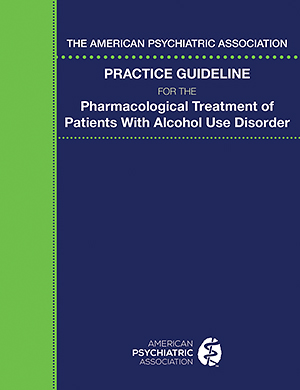Rationale
The goal of this guideline is to improve the quality of care and treatment outcomes for patients with alcohol use disorder (AUD), as defined by DSM-5 (American Psychiatric Association 2013). The guideline focuses specifically on evidence-based pharmacological treatments for AUD but also includes statements related to assessment and treatment planning that are an integral part of using pharmacotherapy to treat AUD. AUD pharmacotherapy is a topic of increasing interest given the burden of AUD in the population and the availability of several U.S. Food and Drug Administration (FDA)–approved medications for this disorder. For these reasons, the AHRQ undertook a systematic review of AUD pharmacotherapy in outpatients (Jonas et al. 2014), which serves as the foundation of the systematic review for this practice guideline. The guideline does not apply to the use of these same medications for indications other than AUD. It also does not address the management of individuals who are intoxicated with alcohol, who require pharmacotherapy for the acute treatment of alcohol withdrawal, or who are experiencing other acute medical problems related to alcohol use. Evidence-based psychotherapeutic treatments for AUD, including cognitive-behavioral therapy (CBT), twelve-step facilitation (TSF), and motivational enhancement therapy (MET) (Anton et al. 2006; Martin and Rehm 2012; Project MATCH Research Group 1998b), also play a major role in the treatment of AUD, but specific recommendations related to these modalities are outside the scope of this guideline.
Worldwide, the estimated 12-month adult prevalence of AUD is 8.5%, with an estimated lifetime prevalence of 20% (Slade et al. 2016a). In the United States, AUD has estimated values for 12-month and lifetime prevalence of 13.9% and 29.1%, respectively, with approximately half of individuals with lifetime AUD having a severe disorder (Grant et al. 2015). Rates of AUD in U.S. adults vary by race/ethnicity (Delker et al. 2016; Grant et al. 2015), with 12-month prevalence rates being highest among American Indians and Alaska Natives (19.2%) as compared with whites (14.0%), Hispanics (13.6%), African Americans (14.4%), and Asian Americans and Pacific Islanders (10.6%). Onset of AUD is most commonly between ages 18 and 29, and men are more likely to be diagnosed with the disorder as compared to women (12-month prevalence in the United States 17.6% vs. 10.4%; Grant et al. 2015). However, in recent decades, differences between men and women in patterns of alcohol use have become less pronounced (Slade et al. 2016b; White et al. 2015), and overall rates of AUD appear to be increasing (Grant et al. 2015).
AUD places a significant strain on both the personal and public health of the U.S. population. According to a 2006 Centers for Disease Control and Prevention–sponsored study (Bouchery et al. 2011), AUD and its sequelae cost the United States $223.5 billion annually and account for significant excess mortality (Kendler et al. 2016). Globally, AUD is associated with a substantial burden of disease in terms of years of life lost to premature mortality, disability-adjusted life years, and years lived with disability (Whiteford et al. 2013). Additionally, problematic alcohol use has been linked to motor vehicle accidents (Kelly et al. 2004); poor academic performance (Williams et al. 2003; Wolaver 2002); increased risk of suicide (American Psychiatric Association 2016; Darvishi et al. 2015); increased criminal activity, including intimate partner violence perpetration (Okuda et al. 2015); increased risk for death by overdose (Jones et al. 2014); and increased transmission risks for human immunodeficiency virus (HIV) and other sexually transmitted infections (Monroe et al. 2016; Rashad and Kaestner 2004; Williams et al. 2016). Additionally, many symptoms of AUD relate to the inability to regulate alcohol use, and relapse of AUD is common (Dawson et al. 2007; Moos and Moos 2006; Tuithof et al. 2014). Associated impairments in insight often lead to delays in accessing care (Chapman et al. 2015). Access to care can also be challenging because AUD often co-occurs with other psychiatric disorders (Grant et al. 2015), and each disorder will need to be treated. Furthermore, the co-occurrence of AUD and other psychiatric disorders reduces treatment outcomes for both types of disorders (Drake et al. 2001) and can be an unrecognized source of treatment resistance.
Despite its high prevalence and numerous negative consequences, AUD remains undertreated. Effective and evidence-based interventions are available, and treatment is associated with reductions in the risk of relapse (Dawson et al. 2006) and AUD-associated mortality (Timko et al. 2006). Nevertheless, fewer than 1 in 10 individuals in the United States with a 12-month diagnosis of AUD receive any treatment (Grant et al. 2015; Substance Abuse and Mental Health Services Administration 2014). Receipt of evidence-based care is even less common. For example, one study found that of the 11 million people in the United States with AUD, only 674,000 received psychopharmacological treatment (Mark et al. 2009). Furthermore, treatment availability and the type of treatment provided can vary based on geography and, in the United States, insurance coverage (Hagedorn et al. 2016; Mark et al. 2015), including formulary restrictions (Harris et al. 2013). In a systematic literature review focused on this disparity, Hagedorn et al. (2016) identified contributing factors at the level of patients (e.g., lack of awareness of treatment options) and clinicians (e.g., perceived low demand and low confidence in the efficacy of pharmacotherapy). Other clinician barriers to prescribing medications for AUD include an inability to provide suitable psychosocial co-interventions and lack of familiarity with medications (Harris et al. 2013; O’Malley and O’Connor 2011). These and other gaps in the care of individuals with AUD suggest that greater efforts are needed to develop and test quality measures related to AUD treatment (Patel et al. 2015; Pincus et al. 2016; Seibert et al. 2015; Thomas et al. 2013; Watkins et al. 2011). Accordingly, this practice guideline provides evidence-based statements aimed at increasing knowledge and the appropriate use of medications for AUD. The overall goal of this guideline is to enhance the treatment of AUD for millions of affected individuals, thereby reducing the significant psychosocial and public health consequences of this important psychiatric condition.



